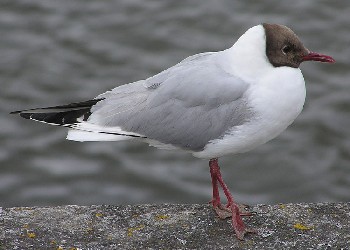
DISTINGUISHING
MARKS
The Black-headed Gull, (Larus ridibundus), is a small
gull which breeds in much of Europe and Asia, and also
in coastal eastern Canada. Most of the population is
migratory, wintering further south, but some birds in
the milder westernmost areas of Europe are resident.This
gull is 38-44cm long with a 94-105 cm wingspan. It
breeds in colonies in large reedbeds or marshes, or on
islands in lakes, nesting on the ground. Like most
gulls, it is highly gregarious in winter, both when
feeding or in evening roosts. It is not a pelagic
species, and is rarely seen at sea far from coasts.
The Black-headed Gull is a bold and opportunist feeder,
which will scavenge in towns or take invertebrates in
ploughed fields with equal relish.
In flight, the white leading edge to the wing is a good
field mark. The summer adult has a chocolate-brown head
(not black, despite the name), pale grey body, black
tips to the primary wing feathers, and red bill and
legs. The hood is lost in winter, leaving just dark
vertical streaks.
This species takes two years to reach maturity. First
year birds have a black terminal tail band, more dark
areas in the wings, and, in summer, a less fully
developed dark hood.

